Inteligent Chatbot for Customer Service
As customers file lawsuits against a company when they are dissatisfied with its service, this project aimed at developing a chatbot mobile app for supporting clients with their complaints, and lawyers when dealing with lawsuits. I was in charge of gathering data on different scenarios and defining the UX interaction flow for the app.
Keywords
Quantitative Analysis
Personas
Empathy Map
Interaction Flow
UX Writer

Team
Applied Computing Group (ACG)
Role
UX/UI Lead Designer
Location
Brazil – Remote
Timeline
August 2019 – July 2020
Problem: How to improve the communication with clients that may become unsatisfied. How to support lawyers in finding information they need to approach clients that may file a lawsuit against the company.
Solution: A chatbot was developed to assist lawyers to obtain information from asking questions about customers who have active lawsuits against the company. The chatbot will also actively talk to clients to try to reduce their complaints about lack of information.
Methodology
The design process considered four main stages: understand, define, design and evaluate. This process was based on the user centered design process and aimed at meeting the needs of end users within the [omitted] company. During the understand phase, user research was carried out, while understanding the problem domain, the types of users (clients and lawyers). During the define phase, we organized the obtained data and characterized the project in terms of problem and goals. Then, we produced user flows and interaction flows during the design phase. Finally, we evaluated our proposal following usability standards and the opinions of end-users.

Execution and Results
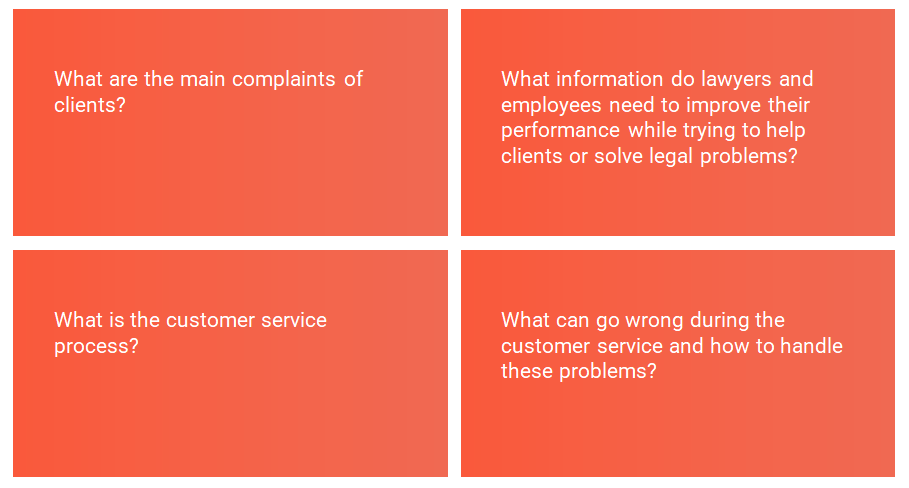
(UNDERSTAND)
01A
The [omitted] company had data on several types of users who had been unsatisfied and filed lawsuits. The information was provided in the context of a power company.
Also, we conducted a document analysis of client support reports that have been generated in the past. We analyzed the factors that negatively impacted customer satisfaction. We also analyzed the customer service processes, and how employees and lawyers dealt with these clients. Using this information, we managed to identify the main questions of this project.
(UNDERSTAND)
01B
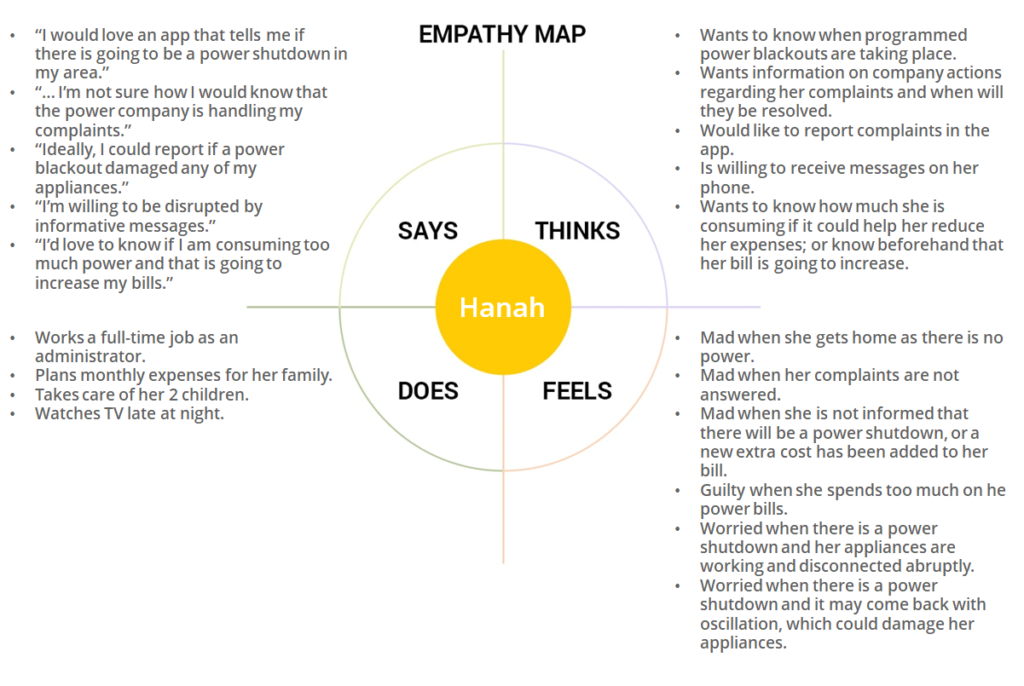

(DEFINE)
02A
We analyzed the data from the document analysis to define which problems users needed support with.
The goal of chatbot is to reduce the dissatisfaction degree of users by informing them of the solution process of their complaints, or in case of problems arise that could impact their satisfaction, inform them of what is being or could be done to reduce their impacts. Also, the chatbot would be embedded into a web application so employees and lawyers are able to get information that is necessary for customer service within the power company.
(DEFINE)
02B
Value propositions summarize why a consumer should use a product or service. We defined what the customer service chatbot provides users and how it addresses users’ pain points.
Also, we defined user stories according to the roles that users could play in the system, to make sure that we were addressing and solving the key problems our users might face when engaging with the customer service chatbot.
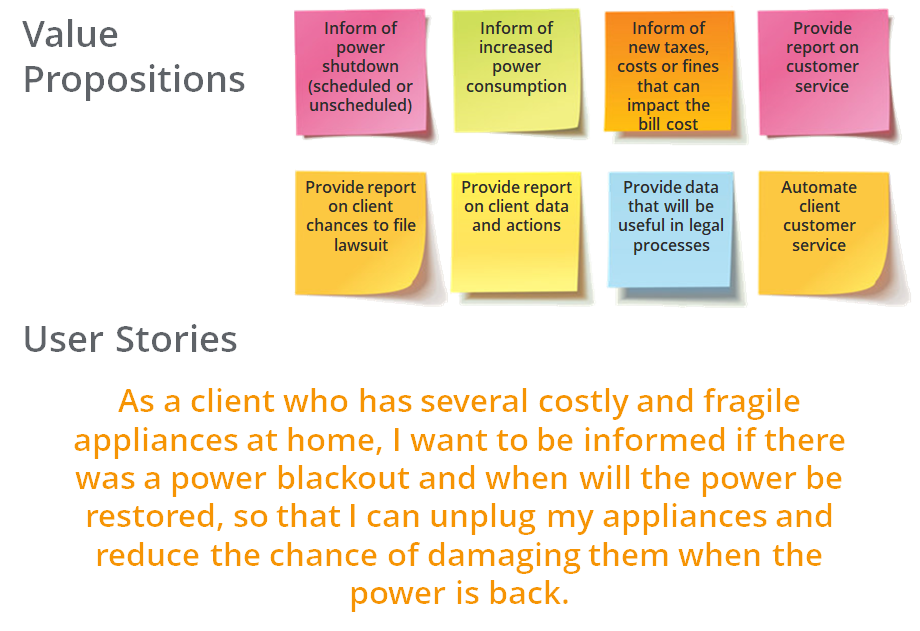
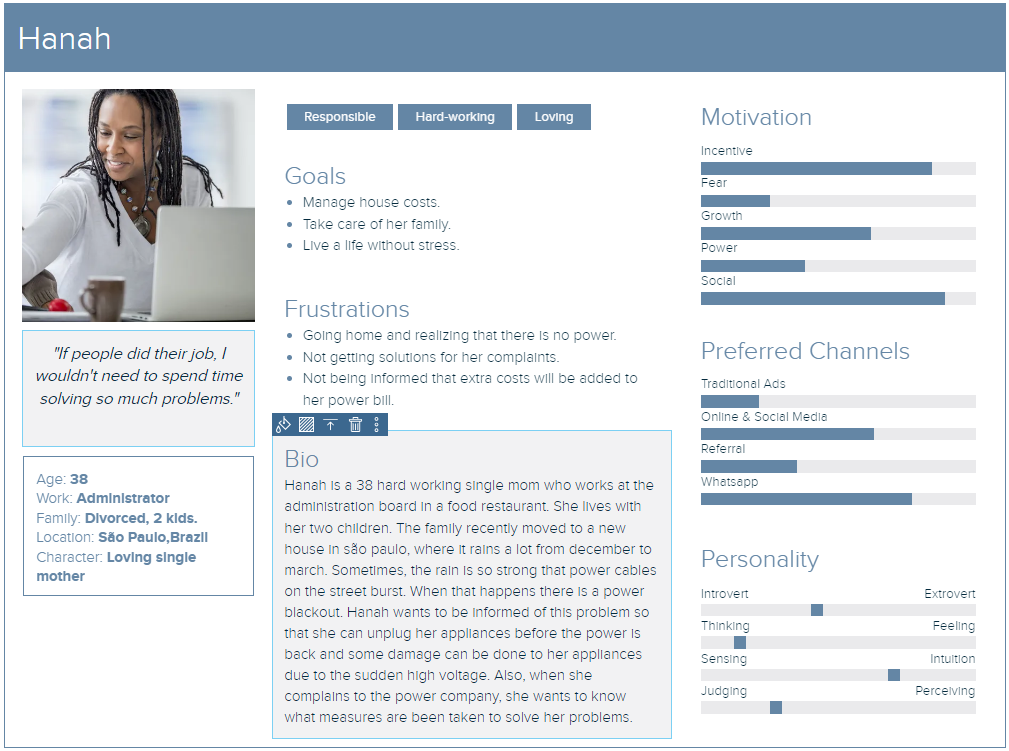
(DEFINE)
02C
Personas are fictional users whose goals and characteristics represent the needs of a larger group of users. Each persona will represent a group of users with similar characteristics. Personas are key to the design process because they reflect the lifestyles of users and give us an idea of how to meet users’ needs or challenges. Here, we present a persona for a client-type user.
03A
(DESIGN)
Through the analysis of the frequently asked questions and the complaints of the clients, we were able to identify: (a) data related to cases in which a client would complain against the power company; (b) measures taken by the power company to either justify a legal action or solve a problem related to customer service; and (c) data required or produced within a costumer attendance.
The identified data was employed to define scenarios in which a client could be approached by the chatbot to: (a) receive information that would be useful to make the client aware of any problems and their solution; and (b) try to handle specific issues or enable the communication with a human attendant. For each developed scenario, we created a text description and a diagram to represent the flow of actions, the required data and the messages that would be provided.
Such scenarios would be useful in the process of developing the chatbot. An example os the interaction flow is presented here.
Scenario 1: After a power blackout, a client verifies that some of his appliances have suffered an electrical damage. If this client has had several blackout complaints or repair requests, after the identification of a Blackout, our chatbot can approach the client, asking if everything is fine, or if he requires assistance due to damaged appliances.

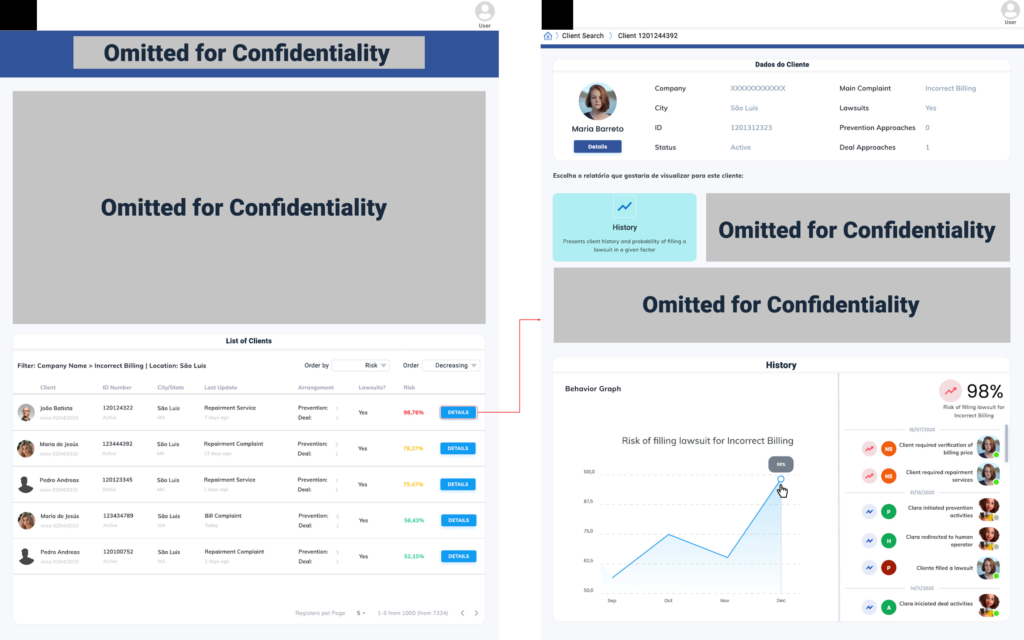
(DESIGN)
03B
To support the decision making process of lawyers/company workers, we designed a high-fidelity prototype of a Web application, showing the structure of the different reports. We considered that lawyers could use the information of conversations with the chatbot to understand the history of a client. Also, as reports with data on the main events and variables highly correlated to lawsuits, we included them as functionalities of the Web application since they could be useful for lawyers. Here, we present part of the prototype.
(DESIGN)
03C
We created conversation extracts to simulate how an interaction between the chatbot and users could accur. For instance, we have some questions asked by a lawyer user to the chatbot. Here, the lawyer wants to gather information about how a client (Hanah) has behaved in terms of power consumption and if she had had any complaints regarding power blackouts. With this information, a lawyer can verify what legal actions can be performed in case Hanah files a lawsuit. Also, customer service employees can verify what is making the client unsatisfied.
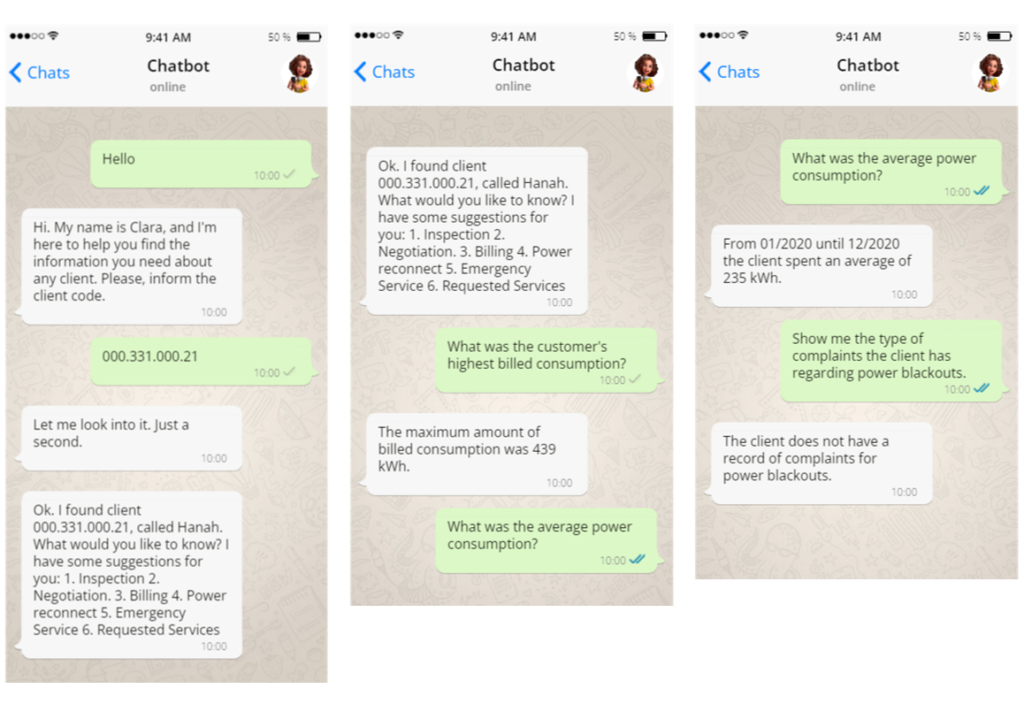
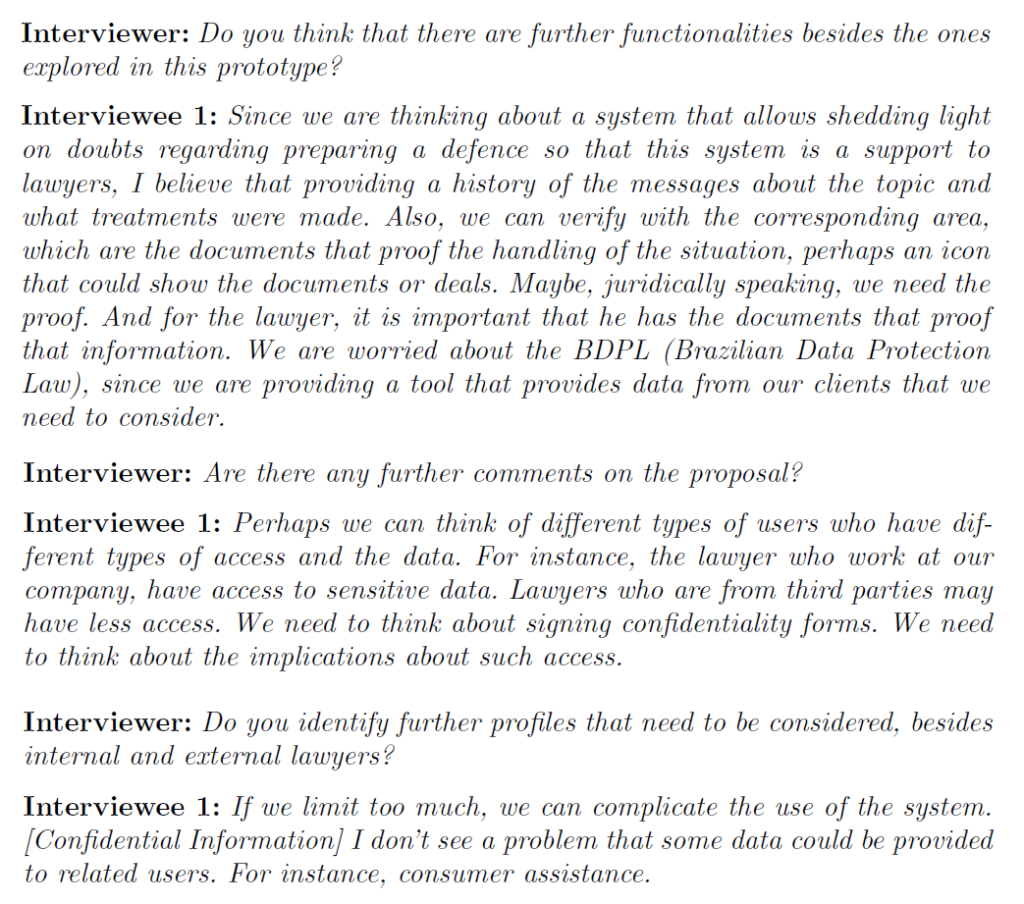
(EVALUATION)
04
After defining the scenarios, personas, interaction flows and developing the high fidelity prototypes, we carried out interviews to identify which requirements and scenarios should be explored, as well as validating the data necessary to perform tasks within the Web system.
The main purpose of this step, was to understand, how the data could be retrieved and if the web system and chatbot could be implemented along with the other existing solutions from the [omitted] power company. We carried out online meetings with possible users of the systems (e.g. lawyers, customer assistants, managers, others). In these meetings, we would discuss which was the necessary data to properly allow an employee/lawyer to track the behavior of a client and decide which measures to adopt when avoiding lawsuits.
Since this project was being developed remotely due to the pandemic of Covid-19, the validation meetings were online, using prototype interaction simulation software. During these meetings we
asked questions related to the adequacy and feasibility of the proposed solutions, as well as improvement opportunities and limitations regarding data access and systems integration. Here, we present an extract of the interviews and some of the answers we obtained.
- The End -
We were able to integrate several requirements elicitation and design approaches to guarantee the quality of the proposed solutions. After applying the interviews and document analysis, we identified the data that needed to be collected. Also, we identified the five main reasons why a client would file a lawsuit, being: power blackout, non-registered consumption, increased consumption, incorrect power cut and incorrect billing. Additionally, through the analysis of company related documents and customer service logs in websites, we managed to identify which processes were applied when dealing with clients’ complaints before they filed a lawsuit. With this information, we defined personas and scenarios for the chatbot interaction. With the information regarding the possible required data and type of interaction of the clients with the lawyers/ company workers, we designed a high-fidelity prototype of the application, showing the structure of the different reports that would be presented to the lawyers, including interaction of clients with the chatbot.
With regards to the lessons learned from this experience, we managed to connect the output of the interviews and document analysis as the input for the Personas, which in turn, were the input of the scenarios and prototype. By searching for real cases of customer services in websites for complaints, we were able to obtain accurate data of how the company handles clients in order to avoid lawsuits, which can be useful for designing the interaction of chatbots, mirroring the interaction with company attendants. The use of interviews along with prototype creation to gain feedback was useful for identifying further data and functionalities, as well as organizing the presentation of the data respecting legal Brazilian requirements on the display of sensitive data.